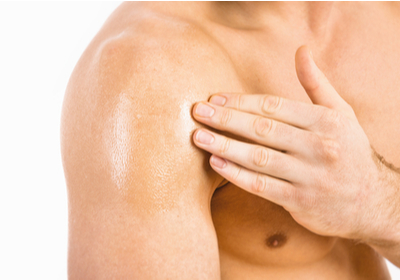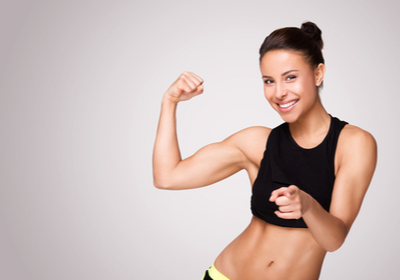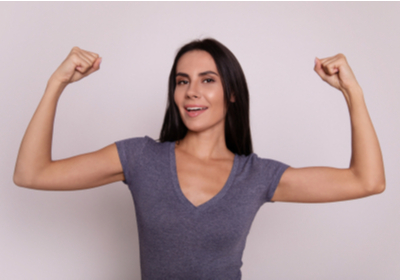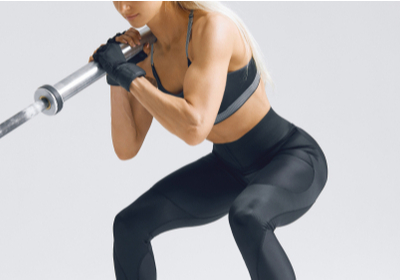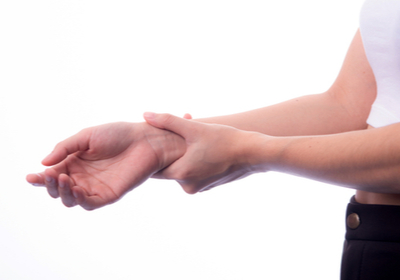VIDEO
Lunge Jumps Variation, Pushups, Step Jumps, Pushup Variation with Jumps, Pushups with Reverse Leg Lifts
- Core
- Arms
- Legs
- Abs
- Gluteus
- Calves
Level:Intermediate
Trainer:
Equipment:Fitness Mat
Lunge Jumps Variation, Pushups, Step Jumps, Pushup Variation with Jumps, Pushups with Reverse Leg Lifts
- Core
- Arms
- Legs
- Abs
- Gluteus
- Calves
Level:Intermediate
Trainer:
Equipment:Fitness Mat
1. Make a lunge with your left leg and change the leg jumping. Do a push-up. Repeat it. 2. Do a push-up and jump to the little сurb after that. 3. Do a push-up and jump changing the side. Repeat it. 4. Do a push-up lifting your right and left legs one by one. Jump to the standing position and jump again putting your legs sideways.
save to ...
RECOMMENDED FOR YOU
- Core
- Back
- Biceps
Duaration: 00:13
save to playlist
- Abs
- Biceps
- Triceps
Duaration: 00:15
save to playlist
- Core
- Arms
- Legs
Duaration: 00:15
save to playlist
- Core
- Legs
- Abs
Duaration: 00:15
save to playlist
- Legs
- Gluteus
- Hips
Duaration: 00:15
save to playlist
- Gluteus
- Quads
- Hamstrings
Duaration: 00:15
save to playlist
- Core
- Arms
- Back
Duaration: 00:15
save to playlist
- Core
- Arms
- Legs
Duaration: 00:15
save to playlist
- Core
- Abs
- Lower Back
Duaration: 00:15
save to playlist
- Core
- Arms
- Legs
Duaration: 00:15
save to playlist
- Back
- Shoulders
- Hamstrings
Duaration: 00:15
save to playlist
- Core
- Arms
- Legs
Duaration: 00:15
save to playlist
Side Plank Hip Dips Variation, Bicycle Crunches, Superman Variation, Vertical Leg Crunches, Scissors
- Arms
- Back
- Legs
Duaration: 00:15
save to playlist
Blog
Many people mistakenly believe that developing shoulder muscles is not important. Well, obviously, it’s not true. So why is it important to work on the shoulder muscles and how to improve them is the topic of this article.
What Are Shoulder Muscles?
Shoulder muscles are basically the muscles that provide shoulder movement. These muscles are voluntary, meaning we control their work. The main functions of the shoulder muscles are the following:
Holding the shoulder joint and its bones in place
Allowing your shoulder joint to rotate
Providing the ability to move your arms forward, up, and down
Shoulder joint protection
As you can see, these muscles are extremely important for performing basic things such as lifting objects or holding something. In addition to that, these muscles are rather important for certain sports that require lots of jerky movements in the shoulder area. For example, dancers, basketball players, tennis players, swimmers, and others. All in all, shoulder muscles do a lot of work, which is why we have to develop them.
Why Do I Need to Work on My Shoulder Muscles?
We have already partly answered this question above, but we’ll give you a more detailed answer just to make things clear. First of all, strong shoulder muscles are a must for many athletes, dancers, and fitness enthusiasts who actively involve arms and shoulders in their activities. The thing is, these muscles are rather fragile, and jerky movements can lead to an injury. At the same time, if one works on these muscles regularly, they significantly lower the risks of possible injuries. But what about people who are not professional dancers or athletes? Well, even if you are not a pro athlete, you still need to go to the gym at least a few times a week to maintain your health, and simple workouts can also cause an injury if you have weak shoulder muscles. So as you might have already understood that working on the shoulder muscles is a must for everyone.
Exercises for Improving Shoulder Muscles
So what workouts can you do to improve your shoulders? Well, why don’t you consider the following ones:
Push-ups
Barbell overhead press
One-hand push-ups
Half-kneeling landmine press
Dumbbell shrugs
Arnold press
Sideways dumbbells
Push press
Barbell press
Wide-grip seated row
Final Thoughts
Stronger muscles minimize the risks of having severe injuries while working out or even doing your regular chores. So no matter if you are a pro athlete or dancer or just a regular person, you should consider working on your shoulder muscles.
Read more
Relief of the biceps is one of the main goals of everybody who does sports and works on their body. At the same time, it’s pretty hard to develop these muscles because of a wide variety of reasons. In this article, we’ll talk about biceps and how to develop these muscles. So let us dive in.
What Is Biceps?
The biceps is the muscle of the upper arm that consists of two parts, which are the long head and the short head. The muscle is connected to the bone with the proximal biceps tendons in the shoulder joint and the distal biceps tendons in the elbow joint. To put it simply, the biceps is a big muscle that is situated in the upper arm from the shoulder to the forearm. The main function of the biceps is to extend and flex the arm at the elbow. It also helps rotate the forearm and hand. So basically, this muscle allows us to lift objects, hold heavy things, and do many other daily things.
Tips on How to Grow Biceps?
Certainly, everybody dreams of relief biceps muscles, but achieving this goal is not that easy. In fact, except for working out, you need to do a lot of other stuff to grow biceps muscles. So here are some tips and tricks on how to grow biceps fast and stress-free:
Eat more protein. For building any muscle, our body needs amino acids and the best way to get them is to eat more protein.
Exercise regularly. In order to succeed in any area, you need to practice regularly. The same goes for developing bicep muscles - you need to work out regularly.
Consider having your thyroid checked. If you eat protein and exercise but you still see no progress, you might want to visit a doctor and have your thyroid checked because there might be some hormonal issue.
Don’t be upset if you don’t see immediate results. Growing biceps takes quite a lot of time, so don’t be upset if after a few weeks of training you see no result. Just continue moving towards your goal, and soon, you’ll reach it.
Make sure you do the right workouts. Not all arm workouts are aimed at the biceps, so you have to ensure you do the right exercises. If you have any doubts, you can always consult your personal trainer or check out this information on the internet.
These simple tips will help you reach your goal faster, so make sure to use them.
Best Workouts Biceps
To wrap up, we would like to provide you with some basic biceps workouts. So without any further ado, here they come:
Barbell curl
Standing dumbbell curl
Cable curl
Zottman curl
Chin-up
Barbell bent-over row
Reverse-grip bent-over row
Underhand seated row
EZ-bar preacher curl
Twisting dumbbell curl
Cable hammer curl
Inverted row
Hammer curl
Meadows row
Concentration curl
Seated cable row
Incline dumbbell curl
Final Thoughts
Gorgeous relief biceps is a dream come true for many men and women. But why dream of it if you can make it real? Explore the biceps workouts in the video section and make your dream of having developed biceps come true.
Read more
Fit and strong arms is the goal of every fitness enthusiast. The thing is our arms are always the center of attention because it’s pretty difficult to hide them under clothes throughout most of the year. So how to make sure your arms look good in any clothes? Well, this is exactly what we’re going to talk about in this article. So without any further ado, let us begin.
Do Not Expect Immediate Results
Most people believe that a month of exercising is enough to see drastic results and therefore if they don’t see any progress, they simply give up. Of course, it’s not the best strategy. In fact, you shouldn’t expect immediate results. You have to move towards your goal gradually and patiently. The thing is, because of our anatomy, growing arm muscles is pretty challenging, especially if you want to get rid of the fat in the triceps area. So take baby steps and do not give up if you don’t see the result after just a few weeks of training.
Always Warm Up before Training
Many people underestimate warming up, thinking it’s not necessary. Obviously, it is wrong. You have to warm up before doing any type of exercise to avoid injuries, especially if you do not do sport regularly. So how to warm up before an arm workout? Here are some simple warmup exercises:
Arm rotation (2-3 minutes)
Arm stretches above your head
Scissors exercise
Wrist rotation (2 minutes)
These simple exercises will help you warm up and proceed to more challenging workouts for arms.
Do Effective Exercises
Not all the exercises can actually help you achieve your goal, which is why it is important to select those workouts that actually work. We recommend the following exercises for developing arm muscles:
Lateral raise
Push-ups
Plank
Dumbbell row
Plank to push-up
Incline bicep curl
Underhand seated row
Prone dumbbell spider curl
Diamond press-up
Javelin press
These workouts will surely help you work on your arms, so make sure to find out more about them as well as try them.
Stretch After Your Workout
Stretching is extremely important for pretty much all muscle groups and arms are not an exception. It helps to relieve muscle tension as well as prevent muscle soreness. So after you are done with the strengthening exercises for your arms, make sure to stretch for at least a few minutes. You can do the following stretching exercises:
Eagle arms
Standing bicep stretch
Reverse prayer
Horizontal arm extensions
Assisted side bend
Overhead triceps and shoulder stretch
Fingers up and down stretch
Cross-body shoulder stretch
These simple stretches will surely help you reduce or even avoid muscle soreness after working out, so give them a try.
Final Thoughts
Strong and fit arms is perhaps the biggest dream of all fitness enthusiasts and not only. Luckily, regular training can help you quickly achieve this goal. So why don’t you start moving towards your dream now?
Read more
The quadriceps is a large and strong muscle that acts as the primary extensor of the knee joint. Because the knee joint carries most of the body's weight, the quadriceps is the main muscle of the lower thigh. Weakness of this muscle, in fact, would simply make it impossible for people to maintain an upright posture. Quads are made up of the four coronary muscles: the straight, inner, outer, and middle muscles. In spite of this, during various exercises, the load falls completely on this muscle. Sure, strengthening your quads is important, so let's give a quick look at a few of the best exercises for them.
Barbell and Dumbbell Lunging
You can do lunges in many different ways. You can do this either with a barbell, or dumbbells, while walking around the gym, or from a stand-up position. Let's consider a variation where the athlete stands in a position using a barbell or dumbbell. This position is similar to the squat position with a barbell on your back. Take a step forward with your right foot. The lunge should make the thigh of the working leg to be parallel to the ground at the low point. Simultaneously, the knee of the left leg almost touches the floor, also forming a 90-degree angle. Back to the previous position. Change legs - take a step forward with your left leg.
Leg Press
The leg press takes as much of the work out of your back and hips as possible. At the same time, it allows you to train with a much heavier weight than a deep squat. In order to place the load on your quads, your feet should be shoulder-width apart while doing the leg press.
Just follow the right workout technique. Press your back and head firmly against the bench, with your legs almost completely straight and resting on the frame and your hands firmly gripping the handles. Bending the knees, form a straight angle between the thighs and calves. Lower the legs back to the previous position.
Single-Leg Squat
Make single-leg squats if you can't go to the gym to train with training machines. It is a perfect way to get your quads workout done. Because it allows you to load your legs without using extra weight. Start in a standing position, extending one leg slightly forward. While squatting down, extend the leg forward and straighten it. Get back to the previous position. Repeat at least 10 times for each leg.
Kick Squat
Standing with feet shoulder-width apart and toes slightly to the side, place your hands at your waist or cradle them in front of your chest. Focus on the center of your feet. Squat down horizontally at the hips, remembering to keep your back straight. Stand up shifting your weight to one side. Lift your knee to a horizontal position and make a kick with your foot. The kick should be done in one movement.
Squats With Fitness Ball
Position your feet a little wider than shoulder-width apart with your toes out to the sides at a 45-degree angle. Grasp the fitness ball, keeping a tense and natural bend at the waist, straight shoulders, and neck. Holding the exercise ball, raise your arms up to shoulder height. As you inhale, begin to bend your knees to your sides, making sure they don't stick out past your toes. Your hips should go down first. Your weight is on your heels. Bring your back slightly forward as you squat down and extend your arms to lift the exercise ball over your head. Perform 30-50 repetitions.
Final Thoughts
Every person dreams of having beautiful legs, and luckily, getting great quads isn't that hard if you know what to do. So why don't you try these exercises?
Read more
Believe it or not, wrist muscles are extremely important. In fact, developed wrist muscles allow you to correctly do such exercises as planks, push-ups, handstands, as well as various workouts with dumbbells. In other words, most sports require strong wrists, and if you want to succeed in gymnastics, martial arts, CrossFit, or climbing, you have to make sure you have strong wrist muscles. But how to achieve that? Let's talk about wrist muscles and how to develop them in more detail.
Why are wrist muscles so important?
Not many people know about the importance of wrist muscles, yet strong wrists are significant in fitness and many other sports. The thing is that developed wrists and joint mobility are significant for avoiding injuries. For example, such sports as tennis, volleyball, CrossFit, boxing, gymnastics, archery, basketball, canoe, and even bowling have a rather serious load on the hands and wrists. Therefore, one wrong move can cause significant damage to the muscles and tendons of your wrists and hands. At the same time, developed and stretched muscles lower the chances of getting severely injured or injured at all. So this is the main reason why working on wrist muscles is so important for pretty much everyone.
Do I need to develop wrist muscles if I don’t do any sports?
Of course, now many of you can come to the conclusion that they do not have to work on their wrists because they don’t do any sports or do those sports that do not require strong wrists. Well, this is, obviously, not true. Perhaps everybody needs to work on their wrists, especially people who work long hours on the computers. The thing is typing and mouse clicking is not particularly good for the health of our wrists because of the positions of our hands during those activities. Moreover, some people even struggle with carpal tunnel syndrome, which is often caused by typing. However, typing is not the only thing that can cause this syndrome. Pianists, guitarists, as well as other people whose work involves repetitive movements of the wrist, are in the risk group. Certainly, this is a rather unpleasant disease but you can lower the chances of getting it by regular exercising. So the answer to this question is: yes, you do need to work on your wrist muscles even though you don’t do any sports.
Best workouts for wrists
Now as we know how important it is to work on your wrist muscles, let us take a brief look at the best exercises for developing these muscles. So here they come:
Dumbbell rows
Holding dumbbells
Wrist stretching
Hand rotation with dumbbells
Tennis ball squeeze
These simple exercises will help you strengthen your wrists and hands and therefore help you maintain your wrist health, so make sure to give them a try.
Final thoughts
As you can see, strong wrists are not only important for athletes, but also for regular office workers, musicians, and pretty much everyone. So why don’t you start working on your wrists now?
Read more
SAVE TO ...

